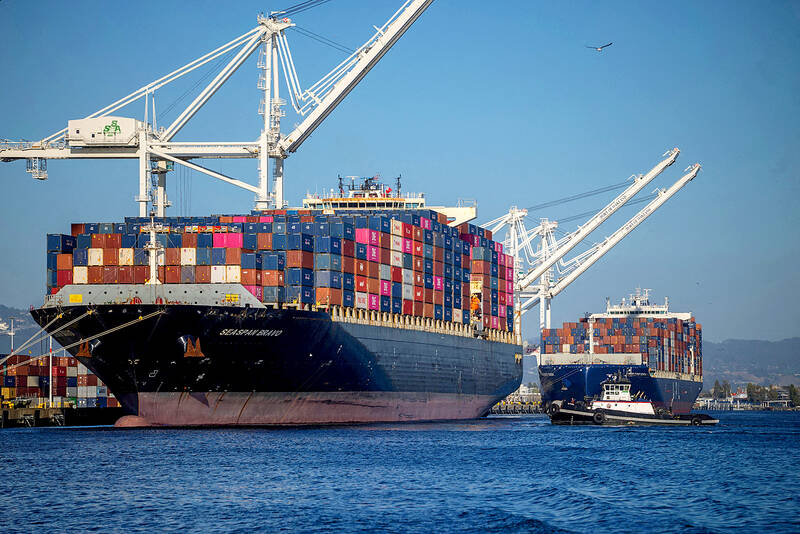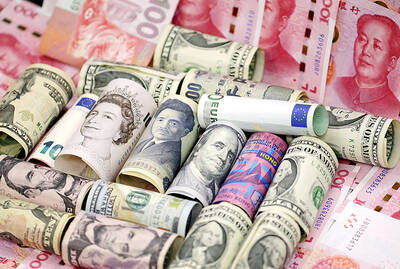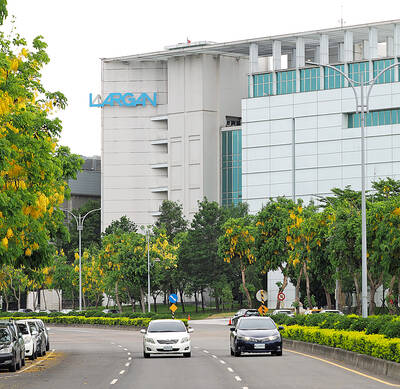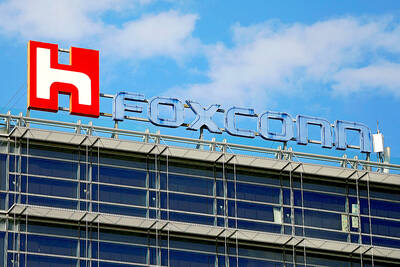Vessels owned or operated by US firms and individuals — or those built in the US or that fly the US flag — are to be charged additional port fees per voyage starting on Tuesday next week, the Chinese Ministry of Transport said.
The fees are a countermeasure against upcoming US port fees on Chinese ships, the ministry said yesterday.
Also starting on Tuesday next week, ships built in China — or operated or owned by Chinese entities — would need to pay a fee at their first port of call in the US. Fees could top US$1 million for a ship carrying more than 10,000 containers, and could rise annually through 2028, according to analyst estimates.

Photo: Reuters
Vessels owned or operated by a Chinese entity would face a flat fee of US$80 per net tonnage per voyage to the US.
The US fees on China-linked vessels, following a probe by the US Trade Representative, are part of a broader US effort to revive domestic shipbuilding, and blunt China’s naval and commercial shipping power.
“It is clearly discriminatory and severely damages the legitimate interests of China’s shipping industry, seriously disrupts the stability of the global supply chain, and seriously undermines the international economic and trade order,” the ministry said.
Over the past two decades, China has catapulted itself to the No. 1 position in the shipbuilding world, with its biggest shipyards handling both commercial and military projects.
The Chinese fees on US vessels could hurt the US less than the US fees to be heaped on the legion of Chinese ships.
Chinese shipyards last year built more than 1,000 commercial vessels, while the US constructed fewer than 10, military and industry analysts said.
For US vessels berthing at Chinese ports from Tuesday next week, the rate would be 400 yuan (US$56) per net tonne, the ministry said.
That is to increase to 640 yuan from April 17 next year and to 880 yuan from April 17, 2027.
For vessels calling at Chinese ports from April 17, 2028, the charge would be 1,120 yuan per net tonne.
Tensions between China and the US have started to deepen since last month, with the two superpowers looking to be struggling to move beyond their current trade tariff truce — a 90-day pause from Aug. 11 that ends on Nov. 9.
Retaliatory tariffs in the US-China trade war this year have sharply curtailed Chinese imports of US agriculture and energy products.
“There is not much impact likely on agriculture trade, but this step goes to show that China is still irritated with US and they are not going to allow US agricultural imports anytime soon,” said one oilseed trader at an international company, which sells soybeans to China. “You don’t take such steps if you’re trying to resolve matters. Chinese crushers might have to do without US beans this year.”

Taiwan’s foreign exchange reserves hit a record high at the end of last month, surpassing the US$600 billion mark for the first time, the central bank said yesterday. Last month, the country’s foreign exchange reserves rose US$5.51 billion from a month earlier to reach US$602.94 billion due to an increase in returns from the central bank’s portfolio management, the movement of other foreign currencies in the portfolio against the US dollar and the bank’s efforts to smooth the volatility of the New Taiwan dollar. Department of Foreign Exchange Director-General Eugene Tsai (蔡炯民)said a rate cut cycle launched by the US Federal Reserve

Handset camera lens maker Largan Precision Co (大立光) on Sunday reported a 6.71 percent year-on-year decline in revenue for the third quarter, despite revenue last month hitting the highest level in 11 months. Third-quarter revenue was NT$17.68 billion (US$581.2 million), compared with NT$18.95 billion a year earlier, the company said in a statement. The figure was in line with Yuanta Securities Investment Consulting Co’s (元大投顧) forecast of NT$17.9 billion, but missed the market consensus estimate of NT$18.97 billion. The third-quarter revenue was a 51.44 percent increase from NT$11.67 billion in the second quarter, as the quarter is usually the peak

Nvidia Corp’s major server production partner Hon Hai Precision Industry Co (鴻海精密) reported 10.99 percent year-on-year growth in quarterly sales, signaling healthy demand for artificial intelligence (AI) infrastructure. Revenue totaled NT$2.06 trillion (US$67.72 billion) in the last quarter, in line with analysts’ projections, a company statement said. On a quarterly basis, revenue was up 14.47 percent. Hon Hai’s businesses cover four primary product segments: cloud and networking, smart consumer electronics, computing, and components and other products. Last quarter, “cloud and networking products delivered strong growth, components and other products demonstrated significant growth, while smart consumer electronics and computing products slightly declined,” compared with the

The US government on Wednesday sanctioned more than two dozen companies in China, Turkey and the United Arab Emirates, including offshoots of a US chip firm, accusing the businesses of providing illicit support to Iran’s military or proxies. The US Department of Commerce included two subsidiaries of US-based chip distributor Arrow Electronics Inc (艾睿電子) on its so-called entity list published on the federal register for facilitating purchases by Iran’s proxies of US tech. Arrow spokesman John Hourigan said that the subsidiaries have been operating in full compliance with US export control regulations and his company is discussing with the US Bureau of